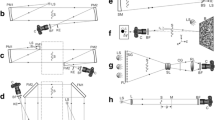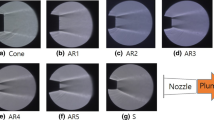Abstract
A spatial-frequency-resolved Schlieren photography was developed for the temporally-sequential visualization of the size-selected, multi-directional turbulent structures induced by the arc discharge in a model type gas circuit breaker. The Schlieren-based method was applied to the atmospheric-pressure DC 55-A arc discharge under gas blasting of 100%CO2, 90%CO210%C2F6 or 80%CO220%C2F6, where C2F6 was used as a substitute additive of commercially available polyatomic molecules. The visualization results clearly demonstrated that strong non-reproducible turbulence existed only for the C2F6-blended CO2 gases. The turbulence size was smaller with increasing the radial distance from the arc. The arc-discharge-induced turbulence showed circular structures in 1–5 mm diameters, which was peculiar to the C2F6-blended CO2 gases. The turbulence existence realizes high interruption performance of gas circuit breakers, which provided a new aspect for the search on the SF6-alternative gases.








Similar content being viewed by others
Data Availability
The data that support the findings of this study are available upon reasonable request from the corresponding author.
References
Thomas E, Browne, Jnr (eds) 2019 Circuit interruption: theory and techniques (New York: Marcel Dekker, Inc.) ch 9.2
Intergovernmental Panel on Climate Change (IPCC) Sixth Assessment Report 2021 The Physical Science Basis (Working Group I)
Christophorou LG and R. J. Van Brunt 1995 SF6/N2 mixtures: basic and HV insulation properties EEE Trans Dielectr Electr Insul 2(5) 952–1003
ABB Inc. 2017 breakthroughs in Switchgear Technology with Eco-efficient gases as an alternative to SF6Tech. Paper
General Electric 2022 GE unveils world’s 1st 420 kV SF6-free g3 circuit-. breaker for gas-insulated substations PRESS RELEASE
Seeger M et al 2017 recent trends in Development of High Voltage Circuit Breakers with SF6 Alternative gases Plasma Sci Technol 4(1) 8–12
Kieffel Y, Irwin T, Ponchon P and J. Owens 2016 Green gas to replace SF6 in electrical grids IEEE Power Energy Mag 14(2) 32–39
Mantilla JD, Claessens M and M. Kriegel 2016 Environmentally friendly perfluoroketones-based mixture as switching medium in high voltage circuit breakers Cigre A3-113
Demura Y, Tanaka Y, Nakano Y, Uesugi Y, Ishijima T 2019 Numerical Thermofluid Simulation of Decaying Arc Behavior in CO2/O2/C5F10O (C5-PFK) and CO2/C4F7N(C4-PFN) Considering More Than Nona-atomic Molecules 5th International Conference on Electric Power Equipment-Switching Technology (ICEPE-ST) B-1-2
Demura Y, Tanaka Y, Uesugi Y, Ishijima T 2019 Numerical Thermofluid Simulation of Decaying Arc Behavior in CO2/O2/C5F10O (C5-PFK) considering more Than Nona-Atomic molecules IEEJ Trans Electr Electron Eng 14(11) 21–28
Kieffel Y, Robin-Jouan PH, Vigouroux D, Lacroix TH, Arabi S and J. Y. Trepanier 2016 Interrupting capability study of high voltage circuit-breakers designed with new g3 eco friendly gas 21st Int. Conf. on Gas Discharges and Their Applications A12
Yokomizu Y, Sakuta T and Y. Kito 1989 A novel approach to AC air arc interruption phenomena viewed from the electron density at current zero J Phys D: Appl Phys 22(1) 129–135
Inada Y, Kumada A, Ikeda H, Hidaka K, Nakano T, Murai K, Tanaka Y and T. Shinkai 2017 comparative study on extinction process of gas-blasted air and CO2 arc discharge using two-dimensional electron density imaging sensor J Phys D: Appl Phys 50(17) 175202
Inada Y, Kamiya T, Matsuoka S, Kumada A, Ikeda H and K. Hidaka 2018 two-dimensional electron density characterisation of arc interruption phenomenon in current-zero phase J Phys D: Appl Phys 51(1) 015205
Inada Y, Nagai H, Yamaguchi S, Kumada A, Ikeda H, Hidaka K, Nakano T, Tabata Y, Demura Y and Y. Tanaka 2018 spatial-filter-installed Shack–Hartmann sensor for two-dimensional electron density visualization of SF6 arc discharge under strong turbulent flow J Phys D: Appl Phys 51(34) 345203
Murai K, Nakano T, Tanaka Y, Uesugi Y, Ishijima T, Tomita K, Suzuki K, Iijima T and T. Shinkai 2016 the LTE thermofluid simulation of Ar/SF6 gas-blast arcs in a nozzle space in an arc device Trans IEE Japan B 136(9) 741–748
Gonzalez JJ, Girard R, Gleizes A 2000 Decay and post-arc phases of a SF6 arc plasma: a thermal and chemical nonequilibrium model J Phys D: Appl Phys 33(21) 2759–2768
Inada Y and T. Fujino 2020 the latest research on high current interruption arcs J Inst Electr Eng Jpn 140(6) 354–357
M. Shigeta 2023 Progress of computational plasma fluid mechanics Jpn. J. Appl. Phys 62(SL) SL0801
Onda K, Tanaka Y, Akashi K, Furukawa R, Nakano Y, Ishijima T, Uesugi Y, Sueyasu S, Watanabe S and K. Nakamura 2020 Numerical study on the evaporation process of feedstock powder under transient states in pulse-modulated induction thermal plasmas for nanoparticle synthesis J Phys D: Appl Phys 53(32) 325201
Tanaka Y, Furukawa R, Nagase Y, Fuwa T, Nakano Y, Ishijima T, Sueyasu S, Watanabe S and K. Nakamura 2021 Numerical Study on Modulation Induced Entrainment Gas Flow and its Promotion of Nanopowder Synthesis in Pulse-Modulated Induction Thermal Plasmas 74th Annual Gaseous Electronics Conference ET42.00004
Bini R, Basse NT, Seeger M 2011 Arc-induced turbulent mixing in an SF6 circuit breaker model J Phys D: Appl Phys 44(2) 025203
Russ S, Strykowski PJ, Pfender E 1994 Mixing in plasma and low density jets Exp Fluids 16 297–307
G. S. Settles 2006 Schlieren and Shadowgraph techniques (Berlin: Springer-Verlag)
Stark H (ed) 1982 application of Optical Fourier transforms (London: Academic Press) 4–7
Huddlestone RH, Leonard SL (eds) 1965 plasma diagnostic techniques (London: Academic Press) 439–441
Pfender E, Fincke J and R. Spores 1991 Entrainment of cold gas into thermal plasma jets Plasma Chem Plasma Process 11 529–543
M. Shigeta 2016 Turbulence modelling of thermal plasma flows J Phys D: Appl Phys 49(49) 493001
M. Shigeta 2019 Modeling and Simulation of a turbulent-like Thermal plasma jet for Nanopowder Production IEEJ Trans Electri Electron Eng 14(1) 16–28
M. Shigeta 2020 Simulating turbulent thermal plasma flows for Nanopowder Fabrication Plasma Chem Plasma Process 40(3) 775–794
Tanaka Y and K. Suzuki 2013 development of a chemically non-equilibrium model on decaying SF6 arc plasmas IEEE Trans Power Delivery 28(4) 2623–2629
Demura F, Nakano Y, Tanaka Y, Ishijima T, Kikuchi R A. Kumada, and Yuki Inada 2021 experimental study on re-ignition process in CO2/C2F6 gas mixture Flow after Application of Quasi-transient Recovery Voltage IEEJ Trans Electr Electron Eng 16(12) 1672–1678
3 M 2022 3 M to Exit PFAS Manufacturing by the End of 2025 PRESS RELEASE
Acknowledgements
The authors like to thank Profs. Kunihiko Hidaka and Katsumi Suzuki of Tokyo Denki University, Prof. Takeshi Shinkai of Tokyo University of Technology, Dr. Tomoyuki Nakano of Central Research Institute of Electric Power Industry, and Dr. Debasish Biswas of Toshiba Corporation for their support during this work. The authors express gratitude to Prof. Tatsutoshi Shioda of Saitama University for the useful discussion on this work. This work was supported in part by a grant of the Specially Promoted Research Projects from Japan Power Academy.
Funding
Specially Promoted Research Projects from Japan Power Academy.
Author information
Authors and Affiliations
Contributions
Y. I. conceived the concept of the spatial-frequency-resolved Schlieren sensor and wrote the main manuscript. Y. I. and A. K. designed the experiments. Y. I., R. K., Y. H., Y. M., Y. T., and Y. N. conducted the experiments. R. K. and Y. H. analyzed the experimental results. Y. T., M. S., and T. F. conducted numerical simulations supporting the interpretation of the experimental results. All authors reviewed and approved the manuscript.
Corresponding author
Ethics declarations
Ethical Approval
not applicable.
Competing Interests
I declare that the authors have no competing interests as defined by Springer, or other interests that might be perceived to influence the results and/or discussion reported in this paper.
Additional information
Publisher’s Note
Springer Nature remains neutral with regard to jurisdictional claims in published maps and institutional affiliations.
Rights and permissions
Springer Nature or its licensor (e.g. a society or other partner) holds exclusive rights to this article under a publishing agreement with the author(s) or other rightsholder(s); author self-archiving of the accepted manuscript version of this article is solely governed by the terms of such publishing agreement and applicable law.
About this article
Cite this article
Inada, Y., Kikuchi, R., Hirano, Y. et al. Spatial-frequency-resolved schlieren sensor for turbulence visualization in arc discharge. Plasma Chem Plasma Process (2023). https://doi.org/10.1007/s11090-023-10415-x
Received:
Accepted:
Published:
DOI: https://doi.org/10.1007/s11090-023-10415-x




